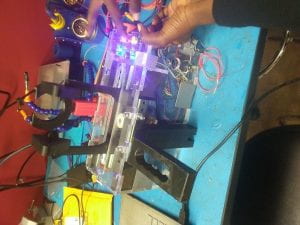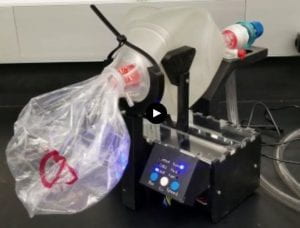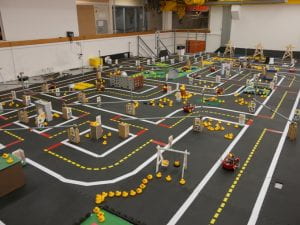Hello again! It’s Thursday again, and we only have 1 more week left in SEED. We are scrambling to make our prototype work so that we can test it in time for our final presentations this time next week.
Last week I didn’t have any pictures of the prototype, so I’ll go ahead and put a picture of our current prototype in here:
I don’t have a detailed breakdown day-by-day of what I’ve done to get it to this stage, but I do know what I did. After I verified the code I left the electronics side of things and went to work on the casing. As you can see in the picture below, the previous team’s device was unprotected from the elements in several ways, including the hole in the top left for the arms to slice, under the user interface panel, and the entire bottom of the device. So to cover the device, we split the work into two parts, I would work on the main body of the device, and my team member Magdah would work on the protective cover for the hole where the arms are. (While we were doing this, Moses and Esther were making amazing progress on the electronics.) I don’t have a picture of Magdah’s cover, but it can probably be viewed on her Week 6 blog.
I came into a lot of problems when trying to dimension the case. The previous team was a senior design team, and they fully dedicated one person to working on the models, so the entire piece is a complicated work of art. We were able to keep their arms, rail system, and holders for the BVM, but had to redesign the rest of the user interface, outer casing, and bottom. It was interesting trying to integrate my visualization into their components, and had to work in a scale of tenths of a centimeter of accuracy. I spent most of this week designing the case. After getting the basic dimensions right, I then had to verify the accuracy. I did this by laser cutting the exact dimensions into pieces of cardboard. A lot of cardboard. As we found out new things to take into consideration I kept adding more and more into the drawing and accumulating a stack of cardboard, until we finally moved to our current Plexiglas. Some of the many things I had to account for was material thickness, screw thickness, bolt height, countersinks, electrical component space, power cord hole, power button, user interface, motor offset, removable cover, etc.
Our first Plexiglas cut wasn’t exact, and we had to do another cut to account for some incorrect dimensions and integration of the cover into the main body. The final schematics of our casing is below. I spent an extra 3 hours after work yesterday (Wednesday) trying to integrate our device into one piece and correctly laser cut the final pieces needed. Currently we have a working prototype!
So before our presentation next week we still have a lot to do. We found out that the previous team’s 3 options were scarily medically inaccurate, and didn’t cover a specific age or correct breaths per minute. For example, the slow setting for them was 10 breaths per minute, which is under the adult’s minimum of 12, and definitely under the infant’s minimum of 30. We found research that splits BPM into 5 age categories, and I calculated the expected tidal volume based on weight averages for each age range. So in our final prototype we hope to have 5, not 3, age options that are more specifically labeled to ages. Each of these age settings will have their own unique 3 BPMs. This means a lot of testing, as we hope to verify 5 different tidal volumes and 15 different settings for breaths per minute. Most likely we won’t be able to do all of this testing, so we will mainly be testing the extremes.
Besides integrating the new settings, we also hope to redo the electronics. It is functional right now, but hard to diagnose if there is a wiring problem because there is too much excess wire in the device taking up space. Since we now have the location of where the electrical components will be and a functioning prototype, a team will work on building a new circuit for our final demonstration.
There’s a lot of testing to do before the final presentation, and not much time left for it, so we have to be smart about what we work on for the next couple of days, and probably meet to work on this over the weekend. “The perplexity of life arises from there being too many interesting things in it for us to be interested properly in any of them.” (Gilbert K. Chesterton)





WOW!!!!You do sooooooooo much sooooooooo well!! Your project is especially challenging, and your team has greatly improved the LLAMA–the motor, circuit board, and dust cover, as Harrell noted when we talked to Moses and Rachael Wednesday, and it sounds like you have improved the case design since then by doing a lot of challenging work.
I am impressed also that you can communicate so well what you do. You cover so much so concisely and clearly. Your talents continue to amaze Harrell and me.